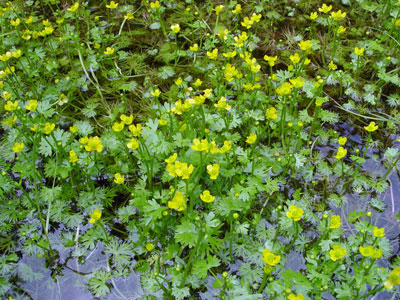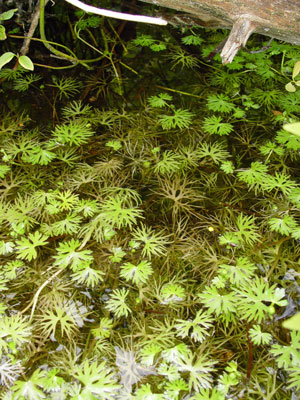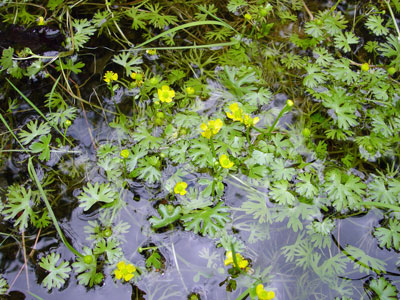DACF Home → Bureaus & Programs → Maine Natural Areas Program → Communities, Plants, and Animals → Rare Plants → Ranunculus gmelinii

Ranunculus gmelinii DC.
Small Yellow Water Crowfoot
- State Rank: S2
- Global Rank: G5T5
- State Status: Special Concern
Habitat: Springy rills, clear cold ponds, shores and meadows. [Open water (non-forested, wetland)]

Range: Eastern Quebec and Nova Scotia to Alaska, south to Maine, Michigan and Minnesota. Also in Asia.
Aids to Identification:This species differs from the common buttercup in being semi-aquatic, the elongate stems creeping or floating in shallow water or sprawling on muddy shores or in meadows. The underwater leaves have long stalks, are flaccid in texture, and are semi-transparent. The above-water leaves are thicker with 3 to 5 lobes. The golden-yellow, 5-petaled flowers occur in clusters of one to four and mature into a cluster of achenes (dry fruits containing seeds) in a rounded head. These achenes have a persistent style that protrudes like a beak. It somewhat resembles R. flabellaris, the yellow water crowfoot, a species that is more common in Maine. R. gmelinii is recognized by its smaller size (petals 3-7 mm long, achenes 1-1.6 mm long with a beak 0.4-0.8 mm long) and achenes that are not thickened and spongy in the basal half.

Ecological characteristics: Ecological relationships in Maine are not well known.
Phenology: Flowers in July and August.
Family: Ranunculaceae
Synonyms: Ranunculus gmelinii DC. var. hookeri (D. Don) L. Benson; Ranunculus gmelinii DC. var. prolificus (Fern.) Hara; Ranunculus gmelinii DC. ssp. purshii (Richards.) Hultén; Ranunculus gmelinii DC. var. purshii (Richards.) Hara; Ranunculus gmelinii DC. var. terrestris (Ledeb.) L. Benson; Ranunculus purshii Richards.
Known Distribution in Maine: This rare plant has been documented from a total of 9 town(s) in the following county(ies): Aroostook, Penobscot.
Reason(s) for rarity: At the southern limit of its range in Maine.
Conservation considerations: Effects of logging are unknown, but partial removal of the canopy would be less likely to adversely affect the plant than complete removal.